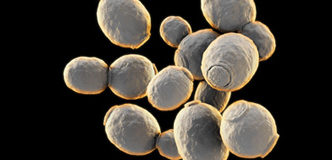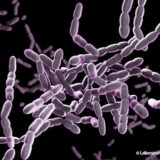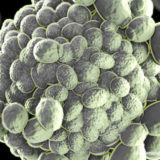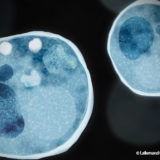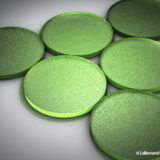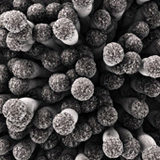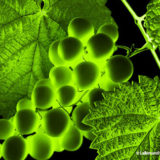| LALVIN BRL 97™ |
Selected by University of Torino - Italy |
Saccharomyces cerevisaie cerevisiae |
Red Wine

White Wine

Rosé Wine

High Brix Juice

Restart Stuck Ferment

|
16 % |
Moderate |
Enhances varietal aromas |
Product Declaration Safety Datasheet |
Lalvin BRL97™ was selected as a result of a four-year study by the University of Torino from over 600 isolates taken from 31 wineries in the Barolo region. The goal was to find a selected natural yeast from Nebbiolo that is able to retain both the color and the varietal character of this grape. BRL97™ has received good feedback from North American winemakers for its color stabilization and sensory contributions in heavier structured reds, such as Zinfandel, Barbera, Merlot and Nebbiolo, with long aging potential.
For more information please contact our distributor.
|
| LALVIN Clos™ |
Selected by the University of Rovira & Virgili - Spain |
Saccharomyces cerevisiae cerevisiae |
Red Wine

White Wine

Rosé Wine

High Brix Juice

|
17 % |
Moderate |
Varietal |
Product Declaration Safety Datasheet Technical Datasheet |
Lalvin Clos® was selected by the University of Rovira i Virgili in Spain from the Priorat region, situated in the province of Tarragona. Vinification trials show Lalvin Clos® has a very good implantation rate under difficult conditions, such as low nitrogen content over a wide range of temperatures. The results of experimental and winery trials with Carignan, Grenache, Syrah, Zinfandel and Tempranillo grapes confirm this yeast’s potential as an excellent tool to enhance aromatic complexity, structure and mouthfeel.
For more information please contact our distributor.
|
| LALVIN ICV D47™ |
Selected by the ICV in the Côtes du Rhône, France |
Saccharomyces cerevisiae cerevisiae |
Red Wine

White Wine

Rosé Wine

|
14 % |
Low |
Enhance varietal character |
Product Declaration Safety Datasheet Technical Datasheet |
Enoferm ICV D47™ is a Côtes du Rhône isolate from Suze-la-Rousse for the production of fullbodied barrel fermented Chardonnay and other white varietals. When left on lees, ripe spicy aromas with tropical and citrus notes are developed. ICV D47™ is a high polysaccharide producer known for its accentuated fruit and great volume. On most white grape varieties, this yeast elaborates wines with ripe stable fruits or jam-like aromas. Thanks to these aromas, the cuvées fermented with the ICV D47™ are a good source of complexity in the blends. Moreover, ICV D47™ contributes to the wine’s silkiness and persistence. Excellent results are obtained for the production of top-of-the-range Chardonnay fermented in barrels, especially when blended with Lalvin ICV D21® fermented Chardonnays.
For more information please contact our distributor.
|
| LALVIN ICV K1 Marquée™ |
Selected by the Institut Coopératif du Vin, France |
Saccharomyces cerevisiae cerevisiae |
Red Wine

White Wine

Rosé Wine

|
18 % |
Moderate |
|
Product Declaration Safety Datasheet |
LALVIN ICV K1 Marquée™ has been isolated in 1972 by Pierre Barre (INRA Montpellier) and then marked by the team of the same institute in order to make the follow-up of its implantation easier. Because of its fermentative abilities on a large temperature range and thanks to its resistance to alcohol, LALVIN ICV K1 Marquée™ allows to improve the security in the alcoholic fermentation in the difficult conditions of the wineries : high temperatures, big tanks, low turbidity, high SO2 content and/or high pressure of the indigenous micro-flora.
For more information please contact our distributor.
|
| LALVIN ICV OKAY™ |
Selected by ICV. INRA and SupAgro Montpellier, France |
Saccharomyces cerevisiae cerevisiae |
Red Wine

White Wine

Rosé Wine

|
16 % |
Low |
Esters |
Product Declaration Safety Datasheet Technical Datasheet |
The selection of the Lalvin ICV OKAY® yeast was the focus of research seeking to identify a new mechanism responsible for the control of SO2 and H2S production in wines. In collaboration with the INRA and SupAgro Montpellier, France, Lallemand and the ICV have selected Lalvin ICV OKAY® yeast for its special abilities to produce very low levels of SO2 and H2S while completing rapid alcoholic fermentation under a broad range of winemaking conditions.
Furthermore, the low acetaldehyde production of Lalvin ICV OKAY® yeast is a great asset in helping to stabilize wines with low to moderate SO2 levels. Recommended for fresh and aromatic wines, even in low temperature and NTU conditions.
Patent application by INRA.
For more information please contact our distributor.
|
| LALVIN Rhone 2323 |
Selected by Inter-Rhône - France |
Saccharomyces cerevisiae cerevisiae |
Red Wine

Rosé Wine

|
15 % |
Moderate |
Enhance varietal characters |
Product Declaration Safety Datasheet Technical Datasheet |
The strain Lalvin Rhône 2323® was selected by the technical service of the Comité Interprofessionel des vins AOC Côtes du Rhône et de la Vallée du Rhône. The selection was carried out from a culture collection of over 600 yeast strains, sampled over the last 15 years in vineyards from the region. This yeast is recommended for the fermentation of red wine and it was retained for high alcohol production, low volatile acidity production and good extraction of phenolic compounds.
For more information please contact our distributor.
|
| Lalvin 71B™ |
Selected by INRA Narbonne - France |
Saccharomyces cerevisiae |
Red Wine

White Wine

Rosé Wine

High Brix Juice

Restart Stuck Ferment

|
14 % |
Low |
Esters |
Product Declaration Safety Datasheet Technical Datasheet |
The Primeur-type wines or “nouveaux” wines represent a signifi cant part of the wines produced in the world. Generally they are made from varieties which aromatic potential is weak. At the time of elaboration, it is then advisable to favor the production of fermentative aromas with the yeast, in order to reinforce the fruity aromas. These wines have to also be easy to drink, which involves a light tannic structure for red wines. Lalvin 71B® yeast has been isolated and selected by the Pr. Maugenet’s team at the INRA Narbonne in this prospect. Its owes its success to its abilities to produce amyl ester (isoamyl acetate), which allows to reinforce the aromatic profi le of wines elaborated from neutral varieties. It metabolizes also a part of the malic acid contained in the musts rich in acid, thus diminishing their strong character. Combined with other yeasts it allows, by melting, the composition of the aromatic range the winemaker looks for. Finally Lalvin 71B® has the property to adsorb a part of the polyphenolic compounds on its cellular wall, thus limiting the tannic structure of primeur red wines.
For more information please contact our distributor.
|
| Lalvin BM4x4 |
Selected by the Consorzio del Vino Brunello de Montalcino and the University of Siena, Italy |
Saccharomyces cerevisiae cerevisiae |
Red Wine

White Wine

Rosé Wine

High Brix Juice

Restart Stuck Ferment

|
16 % |
High |
Varietal |
Product Declaration Safety Datasheet Technical Datasheet |
BM 4X4® is a blend of BM45™ and another yeast known for its fermentation reliability. BM45™ is known and appreciated around the world for its round mouthfeel and stable color (see above description for BM45). However, BM45™ is a slow fermenter and can require substantial nutrients to complete fermentation successfully and without the production of sulfides. While BM45™ has a very strong following among winemakers who enjoy its slow fermentation and its suitability for long maceration programs, there are others who desire the attributes of BM45™ but with a more timely and secure fermentation. BM 4X4® achieves this goal. During the yeast growth phase, BM 4X4® has the unusual capacity of releasing a significant quantity of polyphenol-reactive polysaccharides into the fermenting must. The quantity and the quality of the polysaccharides released during fermentation facilitate the production of red wines with great mouthfeel and improved color stability, with dependable fermentation kinetics under difficult fermentation conditions. In whites, BM 4X4® releases a high level of esters responsible for fruit aromas and also brings roundness to the mouthfeel.
For more information please contact our distributor.
|
| Lalvin DV10™ |
Isolated in the famous French region of high-quality sparkling wine,validated and recommended by the microbiology laboratory at the Pôle Technique et Environnement of CIVC, Epernay France |
Saccharomyces cerevisiae bayanus |
Red Wine

White Wine

Rosé Wine

Sparkling Wine

High Brix Juice

Restart Stuck Ferment

|
17 % |
Low |
Neutral |
Product Declaration Safety Datasheet Technical Datasheet |
Lalvin DV10™ was selected in the Champagne region and is approved by the CIVC in Epernay. DV10™ has strong fermentation kinetics over a wide temperature range and relatively low nitrogen demands. DV10™ is famous for its ability to ferment under stressful conditions of low pH, high total SO2 and low temperature. Low foaming and low VA production characterize it. DV10™ is considered a clean fermenter that respects varietal character and avoids the harsh sensory contributions of other one-dimensional “workhorse” yeasts, such as Prise de Mousse. It is classified as a Saccharomyces cerevisiae bayanus.
For more information please contact our distributor.
|
| Lalvin EC1118 ™ (Prise de mousse) |
Isolated in the famous French region of high-quality sparkling wine |
Saccharomyces cerevisiae bayanus |
Red Wine

White Wine

Rosé Wine

Sparkling Wine

High Brix Juice

Restart Stuck Ferment

|
18 % |
Low |
Neutral |
Product Declaration Safety Datasheet |
Lalvin EC1118™ is the original and is good for barrel fermentations. It ferments well at low temperatures and flocculates well with very compact lees. Under low nutrient conditions, EC1118™ produces a lot of SO2 (up to 30 ppm) and as a result can inhibit malolactic fermentation. It is classified as a Saccharomyces cerevisiae bayanus.
For more information please contact our distributor.
|
| Lalvin Fc9 EDV |
Selected by BNIC, Charentes, France |
Saccharomyces cerevisiae |
White Wine

|
12 % |
Very low |
Esters |
Product Declaration Safety Datasheet Technical Datasheet |
Wines intended for distillation are only one step in obtaining eaux-de-vie and thus require certain qualities to be suitable for heating. The main requirements for winemaking are as follows: alcoholic
fermentation of unracked musts containing no sulphites needs to be fast; malolactic fermentation (not obligatory) needs to be possible immediately after this, and concentrations of certain compounds (higher alcohols, acetaldehyde, ethyl acetate, volatile sulphur compounds) in wines intended for distillation need to be low.
To meet these requirements and help obtain quality eaux-de-vie, Lalvin FC9 yeast has been selected on the Charentes 'terroir' by the BNIC (Bureau Interprofessionnel de Cognac) and the University of Nantes, in collaboration with Lallemand. This yeast is dominant towards the end of fermentation and belongs to a yeast family that is well-represented in the region.
For more information please contact our distributor.
|
| Lalvin ICV D21 |
Selected by the ICV Languedoc, France |
Saccharomyces cerevisiae cerevisiae |
Red Wine

White Wine

Rosé Wine

|
16 % |
Moderate |
Enhance varietal character |
Product Declaration Safety Datasheet |
Lalvin ICV D21® was isolated in 1999 from the Pic Saint Loup Languedoc “terroir” during a special regional program run by the Institut Coopératif du Vin (ICV) Natural Micro-Flora Observatory and Conservatory. ICV D21® was selected for fermenting red wines with stable color, intense fore-mouth, mid-palate tannin structure, and fresh aftertaste. Unlike most wine yeasts, ICV D21® contributes both higher acidity and positive polyphenol-reactive polysaccharides. Strong interactions of the polysaccharides with the floral and fruity volatile compounds contribute to a more stable aromatic profile in the mouth. These attributes avoid the development of cooked jam and burning-alcohol sensations in highly mature and concentrated Cabernet sauvignon, Merlot and Syrah. During fermentation, ICV D21® produces very few sulfides, and it is also noted for its good fermentation performance, even under high temperature and low nutrient conditions. It allows for the expression of fruit from the grapes while reducing the potential for herbaceous characters in Cabernet sauvignon. When blended with wines fermented with Lalvin ICV D254® and ICV D80®, ICV D21® brings fresher, sustained intense fruit and lively sensations beginning in the fore-mouth and carrying through to the aftertaste. ICV D21® is also used in very ripe white grapes, barrel fermented to develop fresh fruit aromas, volume and acidity that complement wines fermented with Enoferm ICV D47™ in blends. Rosé wines fermented with ICV D21® have enhanced red fruit, fore-mouth volume and balance, making it the perfect blending complement to rosé wines fermented with Lalvin ICV GRE™.
For more information please contact our distributor.
|
| Lalvin ICV D254™ |
Selected by ICV in the Côtes du Rhône, France |
Saccharomyces cerevisiae cerevisiae |
Red Wine

White Wine

Rosé Wine

|
16 % |
Moderate |
Enhance varietal character |
Product Declaration Safety Datasheet Technical Datasheet |
Lalvin ICV D254® was selected by the ICV in 1998 from Syrah fermentations in Gallician, south of the Rhône Valley. In red wines, ICV D254® promises high fore-mouth volume, big mid-palate mouthfeel, intense fruit concentration, smooth tannins and a mildly spicy finish. Red wines made with ICV D254® may be blended with Lalvin ICV D80® or ICV D21® to create more concentrated, full-bodied wines. In unripe reds, ferment 25% to 50% of the lot with ICV D254® and the balance with Lalvin ICV GRE™ to help mask vegetative character. As a complement to Lalvin CY3079®, winemakers use ICV D254® for fermenting Chardonnay with nutty aromas and creamy mouthfeel. Very malolactic bacteria compatible.
For more information please contact our distributor.
|
| Lalvin ICV D80™ |
Selected by the ICV in Côte Rotie, France |
Saccharomyces cerevisiae cerevisiae |
Red Wine

White Wine

|
16 % |
Moderate |
Enhance varietal character |
Product Declaration Safety Datasheet |
Lalvin ICV D80® was isolated by Dominique Delteil of the ICV in 1992 from the Côte Rôtie area of the Rhône Valley for its ability to ferment musts high in sugar and polyphenols. With proper nutrition, aeration and fermentation temperatures below 28°C, ICV D80® will ferment up to 16% alcohol. ICV D80® brings high foremouth volume, big mid-palate mouthfeel and intense fine grain tannin to reds. It is one of the best strains for contributing big tannin volume and is characterized by ripe fruit, smoke and a licorice finish. When blended with wines fermented with Lalvin ICV D254® or Syrah, wines fermented with ICV D80® bring more tannin intensity to the blend.
For more information please contact our distributor.
|
Lalvin Persy™  |
Supagro and INRA (Montpellier, France) |
Saccharomyces cerevisiae cerevisiae |
Red Wine

|
16 % |
Low |
Non-production of SO2 |
Product Declaration Safety Datasheet Technical Datasheet |
Lalvin Persy™ is highly recommended to produce wines with fully expression of varietal aroma. Thanks to its unique properties, such as the non-production of SO2 and nonperceptible levels of H2S, Lalvin Persy™ is the right choice to ferment varietals like Shiraz, Tempranillo or Pinot noir, enhancing the fruit character, freshness and aroma persistency. Wines fermented with Lalvin Persy™ from different varietals show a perceptible impact in mouthfeel perception, with round and soft tannins.
|
| Lalvin QA23™ |
Selected by the University of Tras o Montes e Alto Douro - Portugal |
Saccharomyces cerevisiae bayanus |
Red Wine

White Wine

Rosé Wine

High Brix Juice

Restart Stuck Ferment

|
16 % |
Low |
Enhance varietal aromas |
Product Declaration Safety Datasheet Technical Datasheet |
Lalvin QA23™ was selected in Portugal by the University of Trás-os-Montes and Alto Douro (UTAD) in cooperation with the Viticultural Commission of the Vinhos Verdes region. It is used for Chardonnay, Sauvignon blanc, Chenin blanc, Colombard and Semillon for the production of crisp and fresh-fruit intense wines. It enhances aromas of terpenic varietals through its beta-glucosidase activity and is an excellent thiol converter, making it a complementary yeast for developing varietal Sauvignon blanc passion fruit character. QA23™ has low nutrient and oxygen requirements and will ferment juice with low turbidity at low temperatures (10°C) to dryness. It is classified as a Saccharomyces cerevisiae bayanus. Very malolactic bacteria compatible.
For more information please contact our distributor.
|
| Lalvin R-HST |
Isolated in the Heiligenstein region in Austria |
Saccharomyces cerevisiae cerevisiae |
White Wine

Rosé Wine

|
15 % |
Moderate |
Neutral |
Product Declaration Safety Datasheet |
Lalvin R-HST® was selected for its exceptional enological properties in Riesling from trials conducted from 1991 to 1996 in the Heiligenstein region of Austria. R-HST® has a short lag phase and generation time, even at cold temperatures. These features allow it to dominate and persist over spoilage yeast, such as Kloeckera apiculata. R-HST® retains fresh varietal character and emphasizes floral (rose) and mineral characteristics,while contributing body and mouthfeel for an overall complexity and elegance. R-HST® also produces crisp, premium white and Pinot noir wines that develop well over time.
For more information please contact our distributor.
|
| Lalvin R2™ |
Isolated in the Sauternes region by Brian Crozer (Australia) |
Saccharomyces cerevisiae bayanus |
White Wine

Rosé Wine

High Brix Juice

Restart Stuck Ferment

|
16 % |
High |
Esters |
Product Declaration Safety Datasheet |
Lalvin R2™ was isolated in the Sauternes region of Bordeaux by Brian Croser of South Australia. It has excellent cold temperature properties and will ferment as low as 5°C. Without good nutrition and protection against osmotic shock, it can tend to produce VA. For this reason, proper nutrition and protection during rehydration and during fermentation is recommended. R2™ helps produce intense, direct fruit-style whites by liberating fruit and floral aroma precursors. It is recommended for aromatic white varieties, such as Sauvignon blanc, Riesling and Gewürztraminer. It is classified as a Saccharomyces cerevisiae bayanus.
For more information please contact our distributor.
|
| Lalvin RA17 |
Selected by B.I.V.B. in Bourgogne, France |
Saccharomyces cerevisiae cerevisiae |
Red Wine

Rosé Wine

|
15 % |
High |
Enhance varietal aromas |
Product Declaration Safety Datasheet |
Lalvin RA17® was selected by the BIVB in the Burgundy region. It is recommended to enhance varietal characters and to obtain fresh, aromatic and supple red wines. To avoid the formation of sulfides, it requires high nutrient levels and will benefit greatly from nutrition during rehydration. When properly fed, RA17® will develop cherry and fruit aromas in varieties like Pinot noir and Gamay. Wines made from RA17® can be blended with wines fermented with Lalvin RC212®, Lalvin BRL97™ or Enoferm AMH™ to give a more balanced, complex and fuller structure.
For more information please contact our distributor.
|
| Lalvin Rhone 2226™ |
Selected by Inter-Rhône in the Côtes du Rhône, France |
Saccharomyces cerevisiae cerevisiae |
Red Wine

White Wine

Rosé Wine

High Brix Juice

Restart Stuck Ferment

|
18 % |
High |
Enhance varietal aromas |
Product Declaration Safety Datasheet Technical Datasheet |
Lalvin Rhône 2226™ is a vineyard isolate from Côtes du Rhône. It is very alcohol tolerant and highly recommended for high sugar reds and late harvest wines. In red varietals, high color and good structure, as well as black cherry, berry and cherry cola aromas characterize L2226
For more information please contact our distributor.
|
| Lalvin Rhône2056 |
Selected by the ITV in the Côtes du Rhône, France |
Saccharomyces cerevisiae cerevisiae |
Red Wine

White Wine

Rosé Wine

|
16 % |
Moderate |
Esters |
Product Declaration Safety Datasheet Technical Datasheet |
Lalvin Rhône 2056® was selected by the ITV for its ability to maintain varietal fruit aromas and flavors of Côtes du Rhône varieties. It demonstrates good alcohol tolerance as well as low SO2 and VA production over a wide temperature range. Rhône 2056® is a quick to moderate fermenter with relatively high nutrient requirements. Rhône 2056® benefits greatly from good nutrition practices, maintains good color stability and is excellent for fruit-forward-style reds.
For more information please contact our distributor.
|
| Uvaferm 43 Restart™ |
Inter-Rhône, France |
Saccharomyces cerevisiae bayanus |
Red Wine

White Wine

Rosé Wine

High Brix Juice

Restart Stuck Ferment

|
17 % |
Low |
Neutral |
Product Declaration Safety Datasheet Technical Datasheet |
|
| Uvaferm 43™ |
Selected by Inter-Rhône - France |
Saccharomyces cerevisiae bayanus |
Red Wine

White Wine

Rosé Wine

High Brix Juice

Restart Stuck Ferment

|
17 % |
Low |
Neutral |
Product Declaration Safety Datasheet |
Selected for its exceptional ability to restart stuck fermentations, Uvaferm 43® was chosen from among 33 different isolates that were tested against each other, and from the traditional yeasts typically used to restart stuck fermentations. The stuck fermentations used in the selection process were from wines with high alcohol levels (14.3% with 21 g/L RS) and high free SO2 (35 mg/L). The 43® yeast was recently found to be the most fructophilic yeast when compared to other yeasts promoted as being fructophilic. It is classified as a Saccharomyces cerevisiae bayanus.
For more information please contact our distributor.
|
| Uvaferm BDX™ |
Bordeaux region selection - France |
Saccharomyces cerevisaie cerevisiae |
Red Wine

|
16 % |
High |
Varietal |
Product Declaration Safety Datasheet |
A French isolate used extensively in California and Australia since the late 1980s, Enoferm BDX™ has perfect fermentation kinetics and does not generate a lot of heat during fermentation. It is highly recommended for the production of quality red wines, especially Merlot and Cabernet sauvignon, with minimum color loss and enhanced flavor and aroma.
|
| Uvaferm CEG |
Selected by the Geishenheim Institute, Germany |
Saccharomyces cerevisiae cerevisiae |
|
16 % |
Moderate |
|
Product Declaration Safety Datasheet |
|
| VITILEVURE CSM YSEO™ |
Yeast selected in Bordeaux by the Institut Français de la Vigne et du Vin (IFV). |
|
|
|
|
For the elaboration of red wines with aging potential. |
Product Declaration Safety Datasheet |
Selected from the Bordeaux region, VITILEVURE CSM YSEO™ is very well adapted to the winemaking of aging red wines. It is particularly recommended for Cabernet Sauvignon, Cabernet Franc and Merlot.
In terms of its aroma, VITILEVURE CSM YSEO™ enhances the production of elegant, balanced and fruity red wines, (red fruits, strawberry and raspberry) with a decrease of the negative vegetal character.
|
| VITILEVURE SYRAH YSEO™ |
Yeast selected by the oenology laboratories at the Chambre d’Agriculture de la Drôme and the Université du Vin de Suze la Rousse (France). |
|
Red Wine

Rosé Wine

|
|
|
For the production of red, fruity rosé, and varietal wines, notably made from Syrah. |
Product Declaration Safety Datasheet Technical Datasheet |
VITILEVURE SYRAH YSEO™ has been selected from the best Syrah regions of the Rhône Valley. It expresses all the aromatic potentials of this variety, in the different types of regions. VITILEVURE SYRAH YSEO™ is characterized by its capacity to preserve the acidity and to enhance the color intensity.
Due to its ability to enhance norisoprenoid varietal aromas, VITILEVURE SYRAH YSEO™ is used to produce rosé wines from different varietals with persistent red fruit aromas.
|
| VITILEVURE® B+C |
|
|
Red Wine

White Wine

Rosé Wine

Sparkling Wine

|
|
|
Combination of two selected yeasts to secure the alcoholic fermentation. Suitable for spirits base wines (Cognac, etc.). |
Product Declaration Safety Datasheet Technical Datasheet |
VITILEVURE® B+C uses the synergy between two Saccharomyces cerevisiae yeast (different species) to extract colour and tannins.
Sensory profile: VITILEVURE® B+C enhances the wine’s varietal aroma, while respecting its typicity.
|
| VITILEVURE® KD |
|
|
Red Wine

White Wine

Rosé Wine

|
|
|
Selected yeast for wines with strong aromatic typicity. |
Product Declaration Safety Datasheet Technical Datasheet |
VITILEVURE® KD has the property to reveal the aromas of famous varieties, such as Sauvignon Blanc (VITILEVURE® KD is often used in Bordeaux and Loire valley) or Riesling.
VITILEVURE® KD enables Sancerre-type wines with a good ageing potential.
In the case of other Loire valley vineyards, wines made from Sauvignon Blanc fermented with VITILEVURE® KD have regularly obtained medals. In this region, VITILEVURE® KD also gives good results with red wine (Cabernet Franc).
VITILEVURE® KD, with its low nutrient requirements, is also suitable to wines in difficult winemaking conditions.
Its fermenting capabilities make it equally suited to make “nouveau” red wine with high potential alcohol levels and to restart alcoholic fermentations.
|
